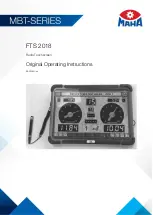
Chapter |
Appendix 2: Optical paths of X-Rays in ARL EQUINOX 5000/5500
Confidential, limited rights
PN AA83865 | Revision A | 25-Oct-2019
Instruction Notice, ARL EQUINOX 5000-5500
Page
50
5.
The sample is able to diffract the beam according to its atomic structure.
6.
The beam stop blocks the direct beam. A proper adjustment of this plat e allows to improve
the low angle detection.
11.2 Monochromator Configuration
The figure shows an ARL EQUINOX 5000 with a CPS120 detector. For the ARL EQUINOX
5500 that is equipped with a CPS590 (bigger radius), the X -ray path is identical except that
the X-rays travel more distance up to the detector.
The figure above describes the X-Ray beam propagation inside of the enclosure when the
shutter is opened and with a monochromator configuration. During this operation, the
enclosure is closed and door is locked.
1.
X-Ray source emission. Scattering is emitted in all directions. The tubeshield is limiting the
X-Rays.
2.
The monochromator crystal allows capturing a given solid angle from the direct beam and
emits a narrow parallel and monochromatic beam.
3.
Primary crossed slits can shape the incident beam (from 0.2 to 0.5 mm for analysis of
samples).
4.
The anti-scattering knife decreases the diffusion from the slits.
5.
The sample is able to diffract the beam according to its atomic structure.









































